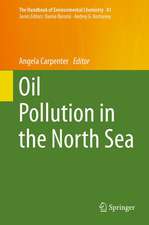Environmental and Health Risk Assessment and Management: Principles and Practices: Environmental Pollution, cartea 9
Autor Paolo Riccien Limba Engleză Hardback – 7 noi 2005
| Toate formatele și edițiile | Preț | Express |
|---|---|---|
| Paperback (1) | 1610.11 lei 6-8 săpt. | |
| SPRINGER NETHERLANDS – 25 noi 2010 | 1610.11 lei 6-8 săpt. | |
| Hardback (1) | 1617.41 lei 6-8 săpt. | |
| SPRINGER NETHERLANDS – 7 noi 2005 | 1617.41 lei 6-8 săpt. |
Din seria Environmental Pollution
- 15%
 Preț: 640.06 lei
Preț: 640.06 lei - 18%
 Preț: 960.13 lei
Preț: 960.13 lei - 24%
 Preț: 1066.76 lei
Preț: 1066.76 lei - 18%
 Preț: 953.35 lei
Preț: 953.35 lei - 18%
 Preț: 944.82 lei
Preț: 944.82 lei - 18%
 Preț: 965.34 lei
Preț: 965.34 lei - 18%
 Preț: 1240.16 lei
Preț: 1240.16 lei - 18%
 Preț: 1225.79 lei
Preț: 1225.79 lei - 18%
 Preț: 1826.54 lei
Preț: 1826.54 lei - 18%
 Preț: 945.79 lei
Preț: 945.79 lei - 18%
 Preț: 1218.83 lei
Preț: 1218.83 lei - 18%
 Preț: 948.29 lei
Preț: 948.29 lei - 18%
 Preț: 956.50 lei
Preț: 956.50 lei - 18%
 Preț: 955.88 lei
Preț: 955.88 lei - 18%
 Preț: 947.50 lei
Preț: 947.50 lei - 18%
 Preț: 2103.87 lei
Preț: 2103.87 lei - 18%
 Preț: 963.91 lei
Preț: 963.91 lei - 18%
 Preț: 969.61 lei
Preț: 969.61 lei - 15%
 Preț: 642.51 lei
Preț: 642.51 lei - 5%
 Preț: 1301.44 lei
Preț: 1301.44 lei - 18%
 Preț: 939.00 lei
Preț: 939.00 lei - 15%
 Preț: 644.95 lei
Preț: 644.95 lei - 18%
 Preț: 1121.43 lei
Preț: 1121.43 lei - 18%
 Preț: 955.08 lei
Preț: 955.08 lei - 18%
 Preț: 1333.42 lei
Preț: 1333.42 lei - 5%
 Preț: 1098.24 lei
Preț: 1098.24 lei
Preț: 1617.41 lei
Preț vechi: 1702.53 lei
-5% Nou
Puncte Express: 2426
Preț estimativ în valută:
309.48€ • 323.100$ • 256.08£
309.48€ • 323.100$ • 256.08£
Carte tipărită la comandă
Livrare economică 05-19 aprilie
Preluare comenzi: 021 569.72.76
Specificații
ISBN-13: 9781402037757
ISBN-10: 1402037759
Pagini: 504
Ilustrații: XX, 480 p.
Dimensiuni: 155 x 235 x 32 mm
Greutate: 0.88 kg
Ediția:2006
Editura: SPRINGER NETHERLANDS
Colecția Springer
Seria Environmental Pollution
Locul publicării:Dordrecht, Netherlands
ISBN-10: 1402037759
Pagini: 504
Ilustrații: XX, 480 p.
Dimensiuni: 155 x 235 x 32 mm
Greutate: 0.88 kg
Ediția:2006
Editura: SPRINGER NETHERLANDS
Colecția Springer
Seria Environmental Pollution
Locul publicării:Dordrecht, Netherlands
Public țintă
Professional/practitionerCuprins
Legal Principles, Uncertainty, and Variability in Risk Assessment and Management.- Sustainability and Making Decisions Under Uncertainty.- Risk, Cost, and Benefit Analysis (RCBA) in Risk Assessment and Management.- Exposure-Response Models for Risk Assessment.- Probabilistic Dose-Response Models and Concepts of Toxicology.- Monte Carlo, Bootstraps and Other Methods to Quantify or Propagate Variability and Uncertainty.- Causal Models: Influence Diagrams, Bayesian Networks, Classification and Regression Trees.- Meta-Analysis, Pooling Sample Data, and Statistical Decision Rules.- Contingency Tables in Risk Assessment and Management.- Statistical Associations and Causation for Risk Assessment and Management.- Risk Assessment Frameworks, Calculations of Risk and Toxicological Doses.- Practical Analysis of Decisions for Risk Management.
Textul de pe ultima copertă
This book is about the legal, economical, and practical assessment and management of risky activities arising from routine, catastrophic environmental and occupational exposures to hazardous agents. It begins where emission and exposure analysis ends by providing estimates or predictions of deleterious exposures. The book covers the essential aspects of environmental and health law, environmental economics, applied statistical and probabilistic methods, fundamental notions of applied epidemiology and toxicology, as well as decision analysis, to provide an integrated overview of how risk assessment and management combine to produce sound societal outcomes. Risk-based methods play a pivotal role in identifying and ranking alternative, sustainable choices, while accounting for uncertainty and variability. Specifically, most reductions in risks require a balancing of the costs and benefits associated with the action to reduce exposure to a hazard and thus risk. This balancing necessarily involves linking exposure and response through causation. Fundamentally, in risk assessment and management, science and law intersect through legal and scientific causation to the point that the failure to provide a sound causal argument can make an otherwise beneficial law or regulation invalid.
The contents of the book have been written with the student’s need in mind: practice, applications and integration take precedence over theory, accomplishing these functions with unparalleled breadth and depth, to provide the methods and criteria for sound decision-making of risk or uncertainty. In addition, each chapter concludes with sample questions to illustrate concepts.
The contents of the book have been written with the student’s need in mind: practice, applications and integration take precedence over theory, accomplishing these functions with unparalleled breadth and depth, to provide the methods and criteria for sound decision-making of risk or uncertainty. In addition, each chapter concludes with sample questions to illustrate concepts.
Caracteristici
An excellent text for those studying risk assessment and management











